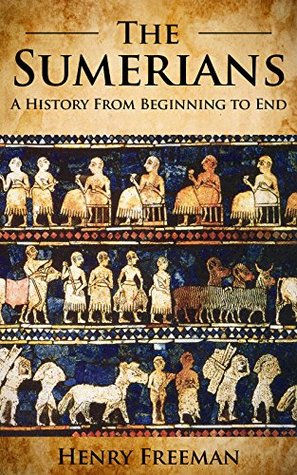More on this book
Community
Kindle Notes & Highlights
In fact, historians knew nothing about the Sumerians less than a century ago, because previously all excavations were looking for Assyrian historical artifacts, according to Kramer. The discovery of the Sumerians came unexpectedly, which led to controversies. As the community interested in these ancient findings slowly embraced the concept that the Sumerian people from 6,000 years ago that resided in southern Mesopotamia were not the same as the Semitic [1] Akkadians or Babylonians, both from northern Mesopotamia, the key findings led to a major rediscovery of the Mesopotamian civilizations.
after the end of the last Ice Age in 15,000-10,000 BCE and the first evidence of agriculture, the Sumerians arrived in Mesopotamia circa 5000 BCE. The early history of Mesopotamia under the Sumerians includes great cultural and technological advances. All of the Mesopotamian empires were largely collections of city-states with the one city with the best army determining domination in the region, until the decline of Mesopotamia in the first millennium BCE, when King Cyrus II (Cyrus the Great) conquered Mesopotamia by 539 BCE.
The development of bronze in this region first occurred in Mesopotamia when the Sumerians discovered adding tin to copper could create bronze circa 3500 BCE.
It is a commonly accepted view that the earliest evidence of settlement in Sumer suggests that the urbanization that took root as a result of the Sumerian irrigation canals during the Uruk period necessitated cooperation. Irrigation led to the foundations for organized societies and cities, but it also led to the salination and later degradation of the soil.
While the cities of Ur and Uruk are considered the first Sumerian city-states, there were twelve separate city-states altogether: Kish, Erech (Uruk), Ur, Sippar, Akshak, Larak, Nippur, Adab, Umma, Lagash, Bad-tibira, and Larsa.
There are numbers of bills of sale, receipts, and documents that, upon further investigation, reveal that the Sumerians documented their economic production using a specific pictographic writing that had more than 2,000 shapes. The sheer volume caused confusion; as a result Sumerians began to develop cuneiform script. The first written tablets in this proto-cuneiform are around 85% administrative or accounting in nature.
Before the Sumerian civilization began to organize itself as a city-state civilization with the use of irrigation, the Ubaid culture of the mid-fifth to late fourth millennium extended from the Arabian Peninsula and the Iranian shores of the Persian Gulf to northern Mesopotamia and western Iran.
Ubaid culture is treated as a foundational stage of the emergence of the Mesopotamian cultural complexity, and is seen as a complex chiefdom or an early state formation. The Ubaid culture was known to be profoundly different from the cultures of the Zagros Mountains and the Khuzistan steppes.
It appears that Elam (the present day Khuzistan province of Iran) refers to the southeastern half of the highlands bordering on Mesopotamia near the Zagros Mountains. Subar (Subartu) is considered the area that generally covered the northeastern highlands to the north of Elam. At the time, these were not political entities, but general geographical terms. Elamites were heavily influenced by Sumer, yet they had a distinct language and were not politically part of Mesopotamia.
If Elam marked the east boundary, then north of them were the Gutians, close to the Zagros Mountains. Further north was Assyria, including Anatolia (central Turkey) in the Northwest. To the west, there was the Arabian Desert and Egypt. Further northeast was Urartu, and to the east, over the Zagros Mountains, there was Parthia and the Iranian plateau.
The Gutians were semi-nomads from the mountains that the Sumerians called subhuman barbarians. It is the Gutians who contributed to the fall of the Akkadian empire after the Akkadians conquered the Sumerians. The Gutian period is considered the dark ages of Sumerian history (2218-2047 BCE).
Trade between India and Sumer in the third millennium BCE was risky; according to Indian scholar Shareen Ratnagar, consignments of cargos between India and Mesopotamia were possibly made only once a year.
While the Sumerians were the first urban civilization, their neighbor Egypt was considered in the Bronze Age the world’s oldest coherent nation-state that emerged in the valley of the Nile.
Bahrain Island in the Persian Gulf functioned as a major crossroads for the Harappan-Sumerian trade.
The Sumerians called themselves Sag-giga (the “black-headed” or “bald-headed” ones) and their southern Mesopotamia land Kengi (“civilized land”) or Kengi-Sumer. Sumer is an Akkadian name, which means land of the civilized kings.
They considered that civilization was a result of the gods’ triumph over chaos. That seems to be one way that we consider being civilized.
a culture becomes a civilization when it has various combinations of elements. These can include extensive food production, codified laws and administration, form of detailed writing, complex social roles, labor specialties and monumental architecture.
The Sumerians believed to a certain extent in predestination as evidenced by Sumerian inscriptions. They refer to the “tablets of fate of the gods.” Sumerians believed that the gods had the power to direct the world. Still, a person could have personal power, with the help of gods, in guiding his current undertakings.
The Sumerian King List proclaimed that kingship descended from heaven first to the city of Eridu and then later after the Great Flood to the city of Kish. City-states had to be administered on behalf of their own local god.
Given that Sumerian literature explores their belief that the gods to relieve themselves of toil created man, then they believed that men literally fed the gods.
“Man is the shadow of god, but the king is god’s reflection.” —A Sumerian proverb
Although education wasn’t universal or compulsory, after training, students could call themselves dubsar or scribe, becoming a member of a privileged class. Once a student learned all the basic cuneiform signs, students went on to learn thousands of vocabulary words


